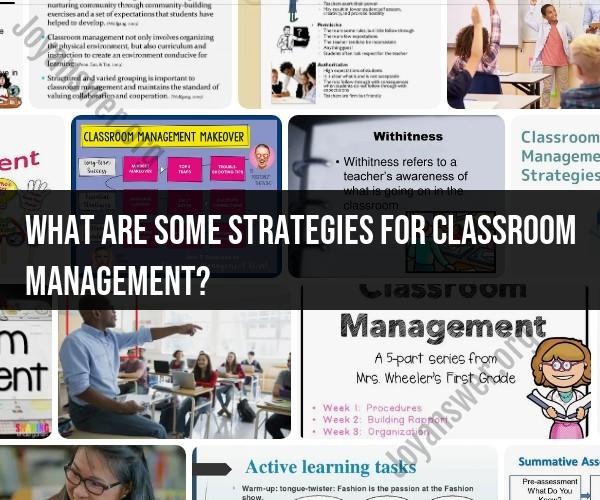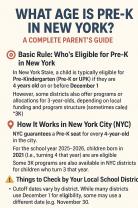What are some strategies for classroom management?
Effective classroom management is crucial for creating a positive and productive learning environment. Here are some strategies for classroom management that can help teachers maintain order and promote effective teaching and learning:
Establish Clear Rules and Expectations:
- Create a set of clear and consistent classroom rules that students can understand. Clearly communicate your expectations for behavior, participation, and academic standards.
Build Positive Relationships:
- Develop positive relationships with your students. Show interest in their well-being and progress, and make an effort to connect with each individual.
Set a Positive Tone:
- Start each class with a positive tone. Greet students, offer encouragement, and create a welcoming atmosphere.
Use Positive Reinforcement:
- Reinforce positive behavior by providing praise and rewards. Recognize and celebrate students' achievements and good conduct.
Classroom Arrangement:
- Organize the classroom layout to facilitate smooth movement, visibility, and interaction. Ensure that students can easily see the board, access materials, and work together.
Clear Communication:
- Maintain clear and open communication with your students. Explain instructions and expectations thoroughly, and encourage students to ask questions when they need clarification.
Consistency:
- Consistency in applying rules and consequences is key. Students should know that the rules will be consistently enforced, which helps prevent misbehavior.
Proactive Behavior Management:
- Anticipate potential issues and address them before they become problems. This includes being proactive in classroom organization and planning.
Classroom Routines:
- Establish daily routines and procedures for tasks like attendance, starting and ending class, transitions, and group work. Routines provide a sense of predictability.
Behavior Contracts:
- In some cases, behavior contracts can be used to outline specific goals and expectations for individual students, along with associated rewards and consequences.
Use of Signals:
- Develop non-verbal signals or cues to redirect or manage student behavior without disrupting the flow of the lesson.
Active Engagement:
- Keep students engaged by using interactive teaching methods, discussions, group activities, and technology. Engaged students are less likely to be disruptive.
Conflict Resolution:
- Teach students conflict resolution and problem-solving skills so they can handle interpersonal issues effectively.
Peer Support and Peer Mediation:
- Encourage students to support each other and resolve conflicts with guidance from a peer mediator or counselor when necessary.
Time Management:
- Efficiently manage your class time to keep students engaged and focused. Have a clear agenda for each class and avoid long periods of inactivity.
Calm and Assertive Presence:
- Maintain a calm and assertive demeanor, even when addressing misbehavior. Avoid reacting emotionally, and instead, respond rationally and firmly.
Individualized Support:
- Recognize that students have unique needs and learning styles. Provide individualized support, accommodations, and modifications when necessary.
Self-Reflection:
- Continually assess your classroom management strategies and adjust them as needed. Reflect on what is working and what could be improved.
Professional Development:
- Seek professional development opportunities to learn and implement effective classroom management techniques. Collaborate with colleagues to share strategies and insights.
Consistent Consequences:
- Be consistent in applying consequences for misbehavior, which can include warnings, time-outs, loss of privileges, and parent-teacher conferences. Make sure students understand the consequences.
Remember that effective classroom management is an ongoing process, and it may require adjustments based on the dynamics of each class and individual students. It's important to create an environment where students feel safe, respected, and motivated to learn, while also addressing any disruptions or challenges that may arise.
Effective Strategies for Classroom Management: A Teacher's Guide
Classroom management is the process of creating and maintaining a positive and productive learning environment. It is essential for ensuring that all students have the opportunity to succeed.
There are many effective strategies for classroom management. Some of the most important include:
- Building relationships with students. When students feel respected and valued, they are more likely to be motivated to learn and follow the rules.
- Creating clear expectations and rules. Students need to know what is expected of them in the classroom. The rules should be fair and consistently enforced.
- Establishing a positive classroom culture. This involves creating a classroom environment where students feel safe, supported, and respected.
- Using proactive approaches to behavior and discipline. This involves anticipating and preventing potential problems before they occur.
- Navigating challenges and conflicts in a positive way. All classrooms will experience challenges and conflicts from time to time. It is important to have a plan for dealing with these situations in a way that is fair and constructive.
Building a Positive and Well-Managed Classroom Environment
Here are some tips for building a positive and well-managed classroom environment:
- Get to know your students. Take the time to learn about your students' interests, backgrounds, and learning styles. This will help you to create a more personalized and engaging learning environment.
- Set clear expectations and rules. At the beginning of the year, go over your expectations and rules with your students. Be sure to explain the purpose of each rule and the consequences for breaking the rules.
- Be consistent with discipline. When students break the rules, be sure to enforce the consequences consistently. This will help to students to understand that you are serious about your expectations.
- Create a positive classroom culture. Focus on positive reinforcement and praise. When you see students doing something right, be sure to let them know.
- Use humor and make learning fun. Students are more likely to be engaged in learning when they are having fun. Try to incorporate humor and fun activities into your lessons.
Proactive Approaches to Classroom Behavior and Discipline
Here are some proactive approaches to classroom behavior and discipline:
- Have clear routines and procedures. Students should know what to expect each day and how to behave in different situations.
- Provide positive reinforcement. When students follow the rules or do something positive, be sure to let them know. This will help to encourage good behavior.
- Give students choices. When possible, give students choices about their learning activities. This will help them to feel more engaged and motivated.
- Teach students self-management skills. Help students to learn how to manage their own emotions and behaviors. This will help them to be more successful in the classroom and in life.
Navigating Challenges and Conflicts in Classroom Management
All classrooms will experience challenges and conflicts from time to time. Here are some tips for navigating these situations in a positive way:
- Stay calm and collected. It is important to stay calm and collected even when you are feeling frustrated. This will help you to think clearly and make good decisions.
- Listen to all sides of the story. Before making a decision, be sure to listen to all sides of the story. This will help you to understand the situation better and make a fair decision.
- Be respectful. Even when you disagree with a student, it is important to treat them with respect. This will help to model the behavior that you expect from your students.
- Focus on solutions. Once you have listened to all sides of the story, focus on finding a solution that works for everyone. This may involve compromise or working together to come up with a plan.
Success Stories and Insights from Seasoned Educators
Here are some success stories and insights from seasoned educators:
- "The most important thing I've learned about classroom management is that it's all about relationships. When students feel respected and valued, they are more likely to be motivated to learn and follow the rules." - Mrs. Smith, 5th grade teacher
- "It's important to be consistent with discipline. When students know what to expect, they are more likely to follow the rules. However, it's also important to be flexible and understanding. There will be times when students make mistakes. It's important to talk to them about their mistake and help them to learn from it." - Mr. Jones, 7th grade teacher
- **"Creating a positive classroom culture is essential for effective classroom management. When students feel safe and supported, they are more likely to be engaged in learning and follow the rules. I try to create a classroom environment where students feel respected and valued












